The first episode of Fire Force was amazing. My jaw dropped to the floor and it stayed there. Explosion after explosion, flame after flame; I was glued to the screen. It would be really easy to keep gushing and just rant about how awesome this singular episode from a TV production is, but I thought we could take the more constructive (and equally as fun) route of asking why it was so good, and highlight the super talented team behind this remarkable work of art.
Background
Fire Force or Enn Enn no Shobutai is a manga series written by Atsushi Ōkubo. You may already be familiar with his name as the manga-ka of Soul Eater, a property you’ve probably already heard of, given how much of a visual darling it was. I’m not sure what kind of deal Ōkubo has with the sakuga cartel, but his work is well cared for. It’s a trend that series director (and episode director in this case) Yuki Yase and his team at David Production uphold to the fullest.
The premise of Fire Force lends itself well to animation: firefighters with various forms of pyrokinesis battle fire demons (dubbed Infernals) that emerge out of spontaneous human combustion. We begin our story with the obligatory introduction of the characters and the world around them. The central protagonist, Shinra Kusakabe, joins the 8th Special Fire Force company, an ensemble cast of lovable misfits tasked with defeating the aforementioned infernals. This episode we dove into Shinra’s backstory, which had a solid pacing and an interesting plot from start to finish. It made for a great self contained experience, one that, when paired with the visuals, dazzled me into writing this series of articles. With that in mind, let’s look into some of the components that stood out.
-STAFF-
Storyboard, Episode Direction: Yuuki Yase
Chief Animation Director: Hideyuki Morioka, Yoshio Kozakai
Animation Direction: Hideyuki Morioka, Riki Matsuura, Yoshio Kozakai, Mayu Fujimoto, Orie Tanaka, Kazuhiro Miwa
Assistant Animation Director: Kazuhito Tominaga
Key Animation: Kazuhiro Miwa, Hiroichi Sato, Yutaka Fukaya, Shiori Tanaka, Yoshio Kozakai, Sumire Fukuzawa,Yuki Fukaya, Kazuki Baba, Norimasa Kanitani, Minori Homura, Mamoru Kurosawa, Yoshihiro Yoshioka, Mizue Ogawa, Nobuo Takahashi, Hiroyuki Ohkaji, Shinya Kameyama, Riki Matsuura, Chihiro Nishikawa, Yuki Nakajima, Yasuyuki Kai, Hisashi Tojima, Kiyomi Wada,
Director Yuki Yase
A lot of hype was generated around Fire Force when it first started. There was a mass migration of staff from studio SHAFT over to their current home at David Production. Allegedly, and I believe this to be true, it was a chain reaction of a few key members moving over, inviting their former colleagues to come with them in attempt to escape the poor planning and rampant scheduling/production conflicts studio SHAFT has been plagued with for over the last decade. Need proof? Let’s go back literally 10 years ago when their flagship series, Bakemonogatari became a runaway hit, and the best selling anime bluray of its time. Episodes were aired unfinished (episode 10 of the Nadeko Snake arc was particularly atrocious in this regard, with only the voice acting completed), or worse, pushed off to being streamed because the final three episodes were nowhere near completed enough to be aired (this is also the reason these episodes are unable to be streamed alongside the rest of the series on Crunchyroll). That’s just one case and example and I’ll leave it at that (kViN at Sakuga Blog went into much greater detail when the show first started if you want to learn more).
One of the individuals to caught up in this migration was director Yuki Yase. Being at SHAFT for so long under Akiyuki Shinbo’s wing, he was pinged as a ‘Shinbo-style director’ among others. However, seeing Fire Force episode 1 for myself, he’s come a long way. Yase has a strong personal flavor, with a taste for post-impressionism. He understands that art is a language that conveys emotion, and has no issue tweeking and changing the source material to better serve the intended feeling of a scene or event.
That being said, he did pick up a few tricks from his time with Shinbo. Yuki Yase has a gift for smooth bursts of aspect-to-aspect transitions for establishing shots. This technique was effectively employed in the opening scene, where flashes of multiple railroad crossing lights quickly built tension, warning of the danger ahead.
Another Shinbo-isim would be the use of extreme long shots. While it’s not uncommon to use long shots to allow the viewer visual distance to contemplate and bathe in the atmosphere of the story, Yase pushes subjects far into the background to create a sense of helplessness. The first shot showcases Shinra’s memory of his childhood, playing hero in the park with his deceased mother. It follows after close-up, intimate shots demonstrating how heart warming Shinra’s time with his mother was. The extreme long shot removes us from that moment distance-wise since those memories and feelings are something Shinra can never get back.
In the second shot, Company 8 has just put down the infernal wife of a factory owner whom the met only moments earlier. The success of Company 8 means her destruction, tinging the event with tragedy. Yase gives us this moment to establish just how nihilistic this moment is, and lets us ponder it. Despite Shinra becoming a hero like he promised his mother, he cannot save the victims of spontaneous combustion, tying a parallel between the haplessness of the two shots.
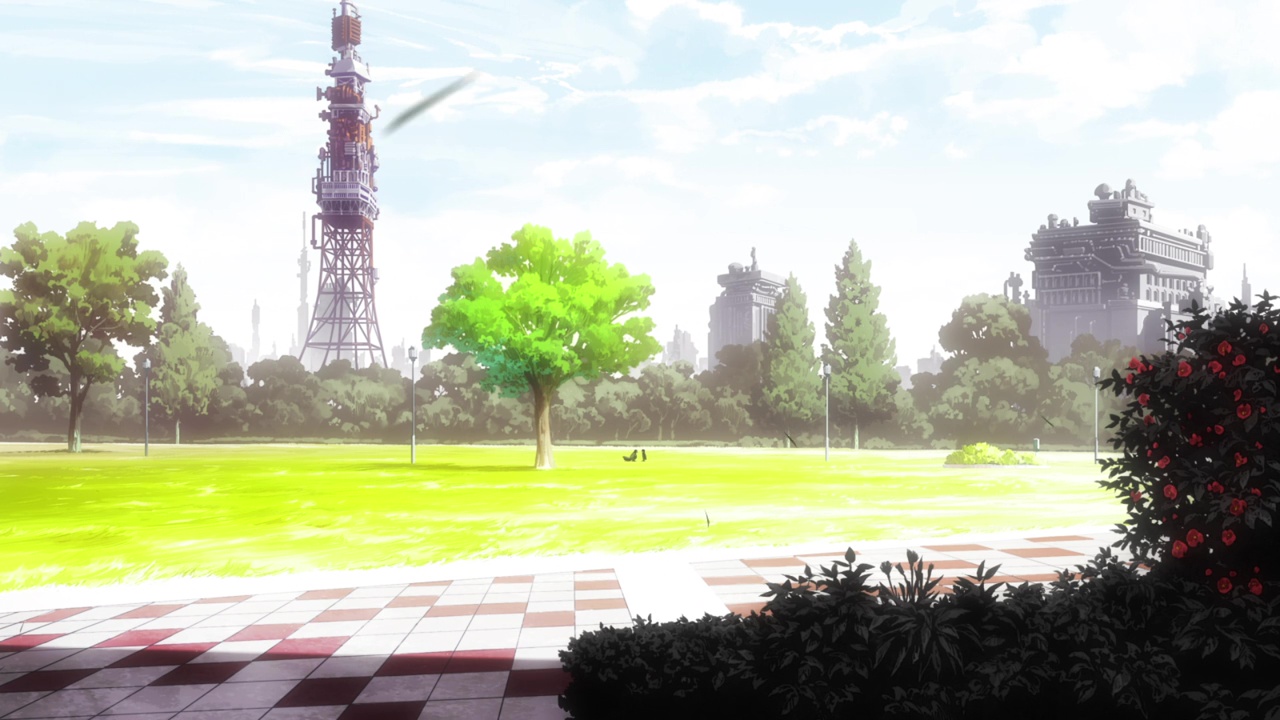
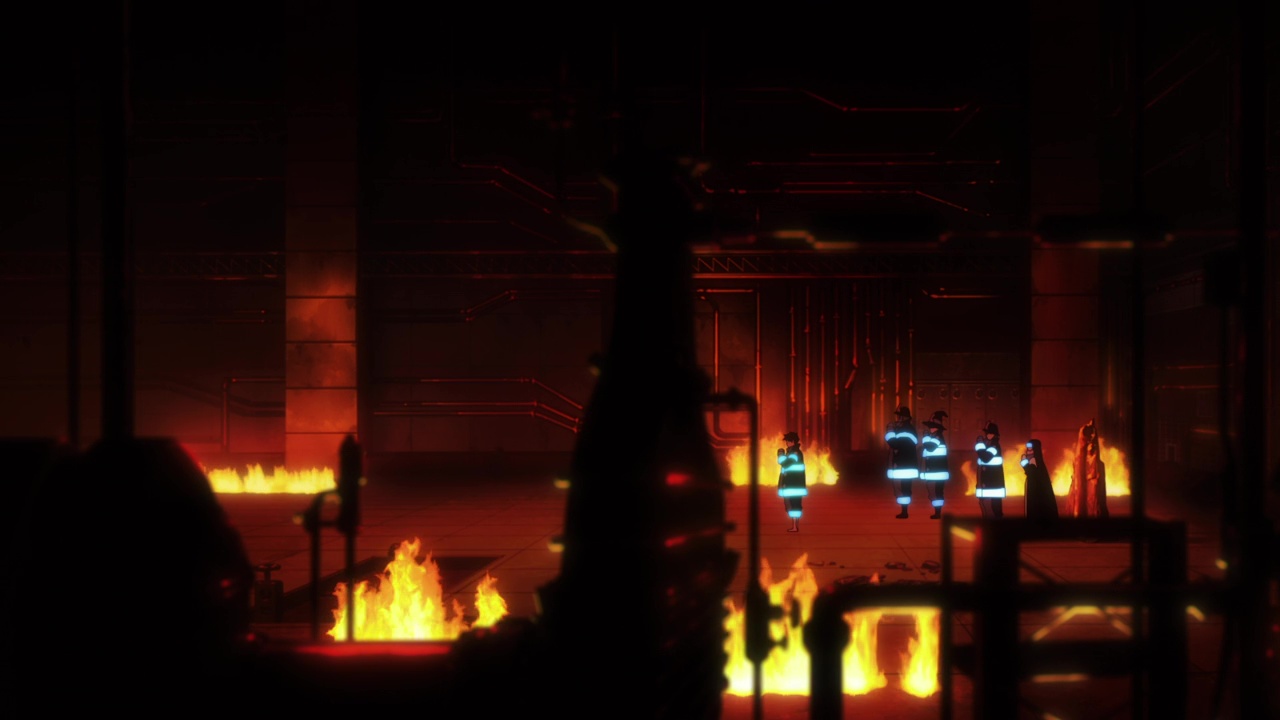
For the most part, Yase stays pretty close to the manga, almost duplicating certain panels down to the ‘t’.
He does rearrange small events to create a better flow of dramatic tension and embellishes at certain points to punctuate the mood, however I found this to elevate the source material rather than detract from it. The changes that are made tend to be where you might expect, such as in action sequences and other scenes where the actual movement is required to convey an event that is very plain in manga.
With a show named Fire Force you can expect a lot of, well… fire. Smoke, explosions, flames, sparks; all effects animation involving fire. While there’s nothing inherently bad about this, there is a constant danger of burn out (pardon the pun) when you have too much of a good thing; diversity is the spice of life. The glowing, light-blue rings on the 8th company’s uniforms really stand out from the sea of orange, red and black. In fact, it would be fair to say that a lot of the color variance this episode was due to lighting effects.
Of course this is not the first time Yuki Yase has played with fire. His episode of Nisekoi: featured Huru in a blazing rage, while episodes 2 and 4 of Nisemonogatari are about the fire sisters. To top it all off, episode 10 of Madoka Magicia (and the last TV aired episode of Madoka) was centered around Akemi Homura’s backstory – Akemi/暁美 meaning flame. I wouldn’t go so far as to say that fire is a ‘tell’ of Yase’s, but I found the coincidence interesting nonetheless.
Animation
Our episode begins with a spark, then flames that whip from one end of the screen to the other, giving birth to a beautiful swirling of glowing fluorescent lines that stretch far into a flash of white light. This abstract display animated by Hiroyuki Ookaji can best be described as an opening statement for the series, almost as if saying our story will pass through fire on a brighter road into the unknown future (at least, that’s what I get out of it). But regardless of meaning, the technicality of the cut can still be appreciated for how lively the movement feels.
He was also tasked with some of the more emotional moments of episode 1. In this next cut, Ookaji show’s a masterful understanding that drawings need to have visual texture. When compared with how smooth and sharp his opening cut is, his billowing smoke saems rough, robust, and gunky. All at the same time.
For animation nerds, I would not be surprised if this was animated straight-through, given how unruly and malleable the smoke is. The burning house is animated to loop, saving on effort without sacrificing quality. Still, to consider that both of these clips came from the same animator with drastically different textures is a triumph in artistry.
Before we leave the talk of texture, we need to explore Mamoru Kurosawa‘s work this episode. If I have a favorite cut this episode, this would be the one. It just feels so incredible raw, almost as if it didn’t finish going through the color and compositing process. It’s as if the drawing were made, put in order, and displayed flipbook style.
This next cut showcases some of the changes Yuki Yase made, and it’s obvious why he chose to do so. The opening combat sequence was entrusted to Yuki Fukaya, who did a wonderful job making the opening fight feel exciting and kinetic. Doing a quick search for other credits under his name (深谷悠貴), I was unable to find other credits under him other than those on Fire Force (not saying they don’t exist, just that I was unable to find them). This strikes me as odd given that he’s not only a key animator, but an animation director in later episodes, positions that are usually reserved for seasoned staff. However, seasoned or not, Fukaya does good work!
A quick disclaimer, the infernal in the clip above was not animated by Fukaya. It was actually done by ace animator and animation director Kazuhiro Miwa. A major tell of his is the impact frame, or a split second ‘negative frame’ that is inserted at the exact moment of kinetic force. It’s a subtle, nearly subliminal technique that gives the whatever action it’s enforcing a bit more ‘oomph’.
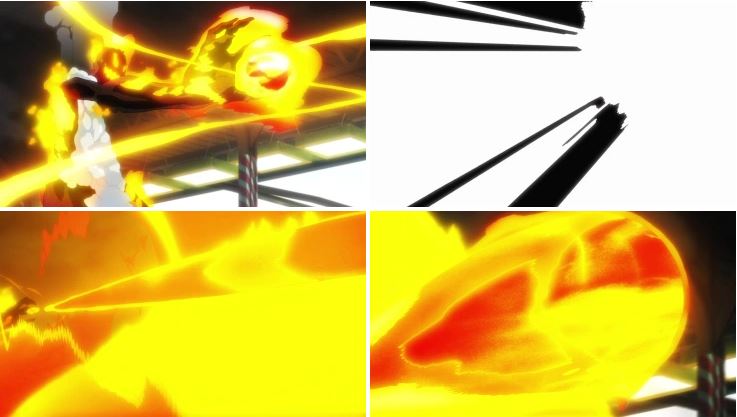
When you slow these shots down, you’re really able to to appreciate the meticulous care and effort put into making just a few seconds of animation look stylish. Also not the very grainy, almost sandlike texture on the fireball.
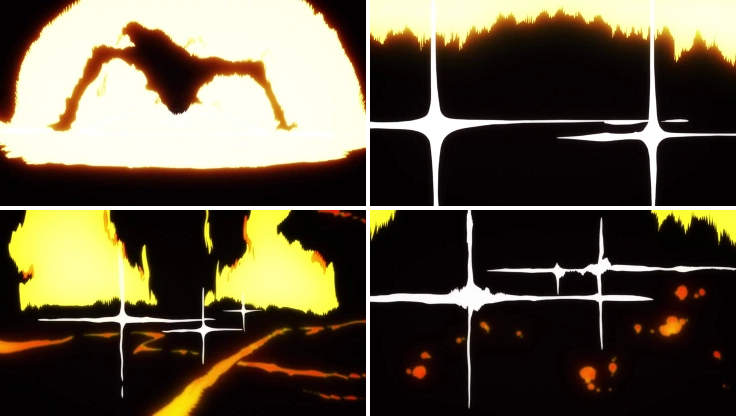
Even looking at them isolated like this, they stand on their own. In motion, it’s even more impressive. This is part of the reason why the color palate and repeated flame effects never feel stale or played out. A few drawings on screen for mere fractions of a moment are characterizing each explosive bit of animation. It gives a unique flavor to the effects animation. Not only that, but it’s strikingly different without being, dare I say, inconsistent with the episode as a whole. Miwa’s work stands out and elevates the cuts that come both before and after. The mark of a masterful animation director.
There are a ton of amazing cuts that I could go on at length about, but I think I want to wrap up this post with one I feel was kind of overlooked. Too often do we take the lip flaps in anime for granted. Characters speak, and all we want to see is a mouth flap. It’s so common that many Western animators try to point it out as a defining aspect of anime, almost with a sense of disdain. Enter Riki Matsuura, who proves them all wrong by animating the exact dialog being spoken in this cut.
It’s realistic character acting that lends further gravitas to the spoken word in the perfect marriage of audio and visual storytelling. It’s a paragon example of how multiple media can come together to create something better than the sum of their parts. What’s tragic is that this subtlety was most likely washed away when dubbed into English, as the original lines spoken are in Japanese. But what needs to be appreciated here is not only the mouths taking the proper shape to form words, but the angle to which they do so. Matsuura nails the perspective from below, literally having the animation talk down to us. Brilliant!
Again, there are many more bits of animation that could be picked apart and analyzed frame by frame, but in all reality, the best way to take this all in is to see it for yourself. The moment I finished watching Fire Force I felt the need to write what you are read right now. If that’s not enough for you to treat yourself, then I don’t know what is!
Like our content? Feel free to support us on Ko-Fi!
You might also be interested in
Oshi no Ko & (Mis)Communication – Short Interview with Aka Akasaka and Mengo Yokoyari
The Oshi no Ko manga, which recently ended its publication, was created through the association of two successful authors, Aka Akasaka, mangaka of the hit love comedy Kaguya-sama: Love Is War, and Mengo Yokoyari, creator of Scum's Wish. During their visit at the...
Benoît Chieux, a career in French animation [Carrefour du Cinéma d’Animation 2023]
Aside from the world-famous Annecy Festival, many smaller animation-related events take place in France over the years. One of the most interesting ones is the Carrefour du Cinéma d’Animation (Crossroads of Animation Film), held in Paris in late November. In 2023,...
Directing Mushishi and other spiraling stories – Hiroshi Nagahama and Uki Satake [Panels at Japan Expo Orléans 2023]
Last October, director Hiroshi Nagahama (Mushishi, The Reflection) and voice actress Uki Satake (QT in Space Dandy) were invited to Japan Expo Orléans, an event of a much smaller scale than the main event they organized in Paris. I was offered to host two of his...

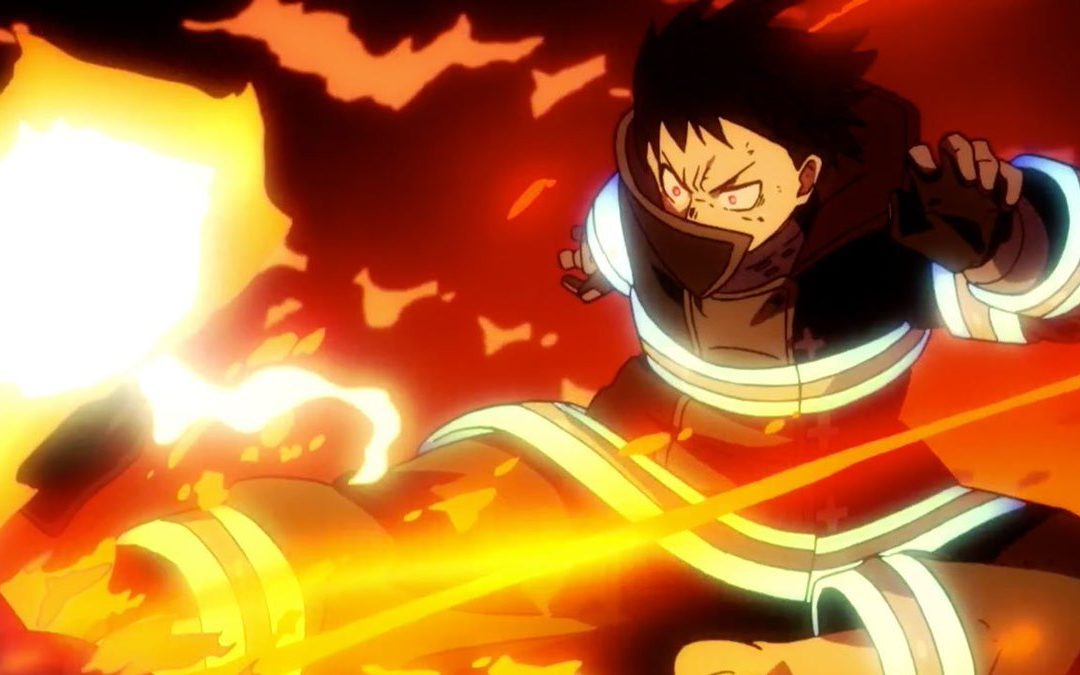
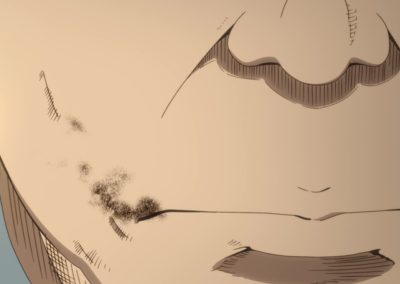
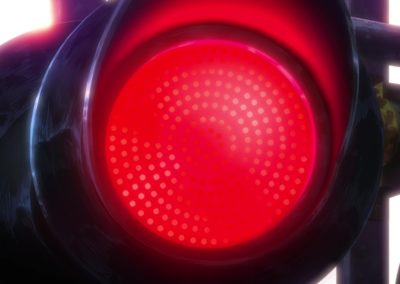
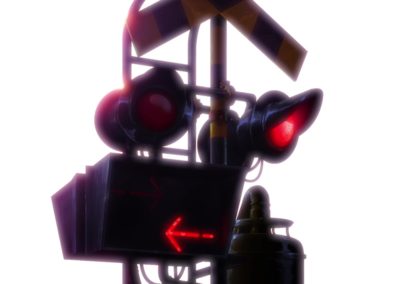
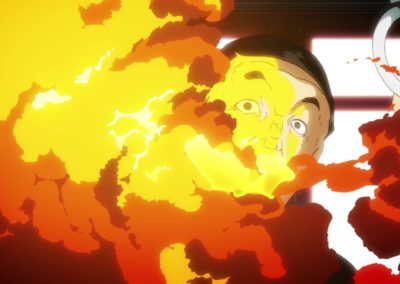
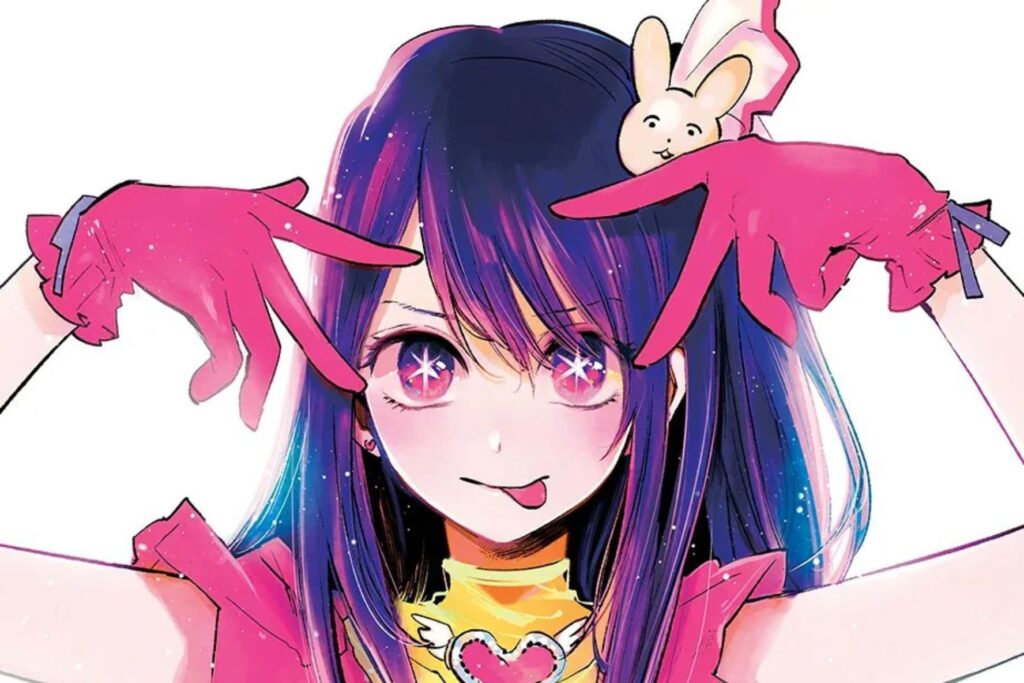
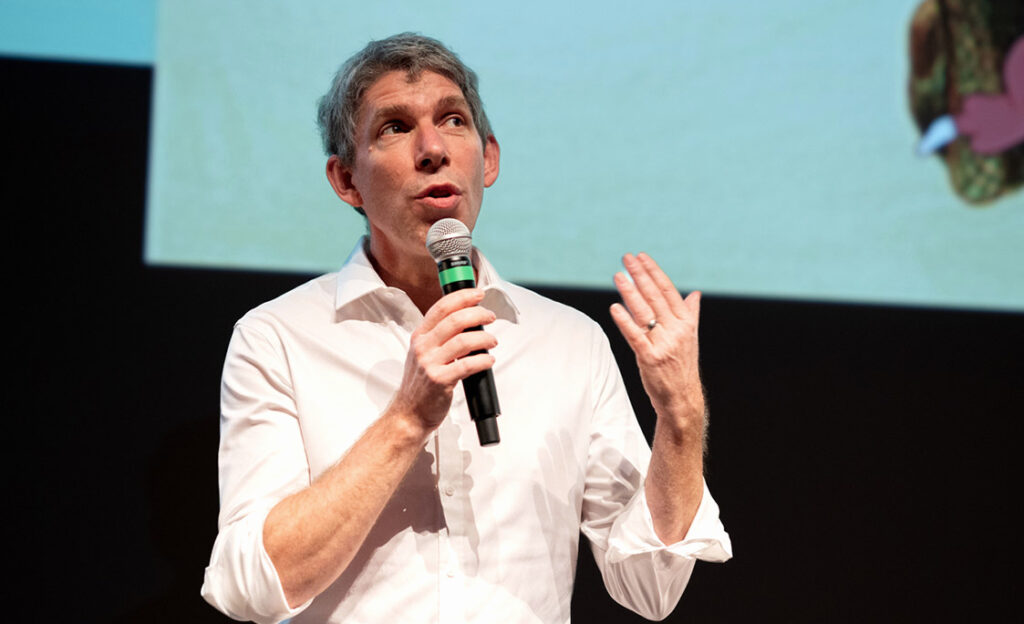
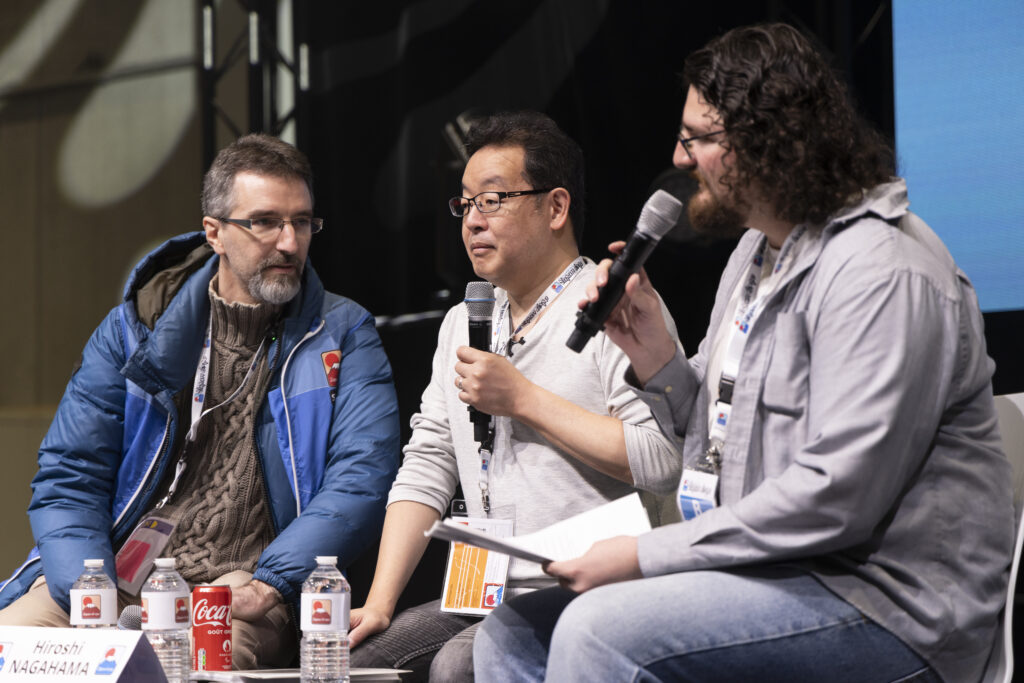
Recent Comments